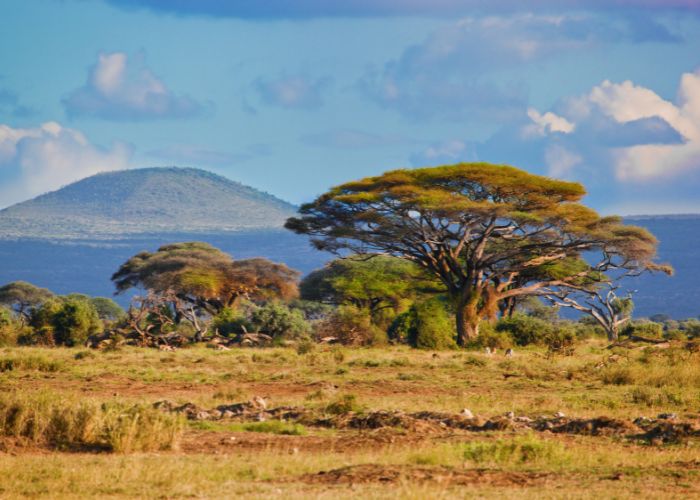Whether you’re headed to West Africa for a short visit or planning on putting down roots, knowing about the type of climates in West Africa is essential.
The local climate varies across three major zones: Guinea, Sahel, and Savanna. Join Jobomax Homes, the leading residential developer in the region, as we explore the types of climates you can expect in this diverse and fascinating part of the world.
What Are the Major Types of Climate in West Africa?
The climate in West Africa varies across regions. It can be categorized into 3 zones based on latitude:
Guinea
Located at 4°N to 8°N along the Atlantic Ocean, Guinea has a sub-humid climate.
The climate is characterized by wet and dry seasons. Guinea experiences hot weather year-round and a rainy season influenced by movements in the Inter‐Tropical Conversion Zone and the southwesterly monsoon wind.
The tropical zone receives rainfall between 1,600 mm (63 inches) and 2,000 mm (79 inches) while the subequatorial zone is subject to more rain, experiencing anywhere between 2,100 mm (83 inches) and 5,000 mm (197 inches).
Sahel
The Sahel zone is located at 11°N to 16°N. It is semi-arid, with a year-round climate similar to the Sahara. The rainy season usually lasts 2 to 3 months, with 200 mm (8 inches) to 800 mm (31 inches) of rainfall annually. Its wet seasons occur during the boreal summer months from June through September.
Because of the high precipitation, the region boasts several lakes, including the popular Lake Chad.
Savanna
With the Sahel as a transitional zone, the Savanna tends to be more humid with semi-arid weather across seasons. It is located at 8°N to 11°N and receives 750 mm (30 inches) to 1250 mm (150 inches) of annual rainfall.
The Savanna can be further subdivided into 3 categories depending on how long the dry season lasts:
- Wet savannas have 3 to 5 months of dry weather.
- Dry savannas feature 5 to 7 months of minimal to zero precipitation.
- Thornbrush savannas are the driest, experiencing more than 5 to 7 months of dry seasons.
In addition to these three zones, West Africa cuts through the Sahara Desert.
African Transition Zone’s Desert Climate
West Africa encompasses parts of the Sahara Desert known as the African Transition Zone. This massive area covers a whopping 31% of the continent. The weather is hot and dry while temperatures reach as high as 47°C! (117°F) As you might expect from any desert, the African Transition Zone only receives 76 mm (3 inches) of rainfall annually.
Is West Africa a Good Place To Live Because of the Climate?
West Africa enjoys a warm year-round climate. Unlike some parts of the world that experience 4 seasons, this region only has wet and dry seasons.
The dry season usually happens from October to March while the wet season occurs between May and October. During the drier months, temperatures are more pleasant, bugs are fewer, and it’s a great time to engage in outdoor activities like spotting wildlife and visiting the beach. Residents are also familiar with the harmattan, a dusty and dry trade wind from the Sahara that arrives during dry months.
If you prefer warm and humid climates over cold and wet ones, West Africa could be the haven you’re looking for. Having only two seasons makes weather patterns more predictable and planning easier. You don’t have to worry about buying winter clothes, heating systems in your home, getting your car winter-ready, or snowstorms.
West Africa and Climate Change
West Africa, particularly its urban areas, is more vulnerable to climate change. According to the United Nations Economic Commission for Africa, the region is predicted to experience temperature increases from 1.5°C to 3°C (34°F to 37 °F) . This has serious implications for the populations’ productivity, health, and food security. Heat waves are another serious concern in the region.
In the face of these challenges, West African governments must take steps to mitigate the effects of climate change. In 2022, the Economic Community of West African States (ECOWAS) earmarked $294 billion to fund their Regional Climate Strategy (RCS). The RCS aims to
- Reduce the carbon impact of facilities while strengthening their adaptive capabilities
- Improve regional policies, programs, and measures
- Strengthen political dialogue
ECOWAS also committed to setting targets that can help the region adapt to and mitigate climate change.
Tips for Choosing a West African Country to Live In
West Africa comprises 16 countries. When deciding where to live, consider:
Culture
West Africa is known for its diverse cultures. The best places to experience the region’s unique traditions, beliefs, and ideologies are Senegal, Ghana, and Gambia.
Note that Nigeria is home to more than 150,000 expatriates. Here, you’ll be able to enjoy a comfortable subtropical climate, an active nightlife, and easy access to many luxuries.
Quality of Life
The African Development Bank (ADB) reported a substantial improvement in the region’s quality of life in the past few decades. There have been enhancements in healthcare, educational standards, and other basic services. Meanwhile, economic growth has improved government practices, increased jobs, and enhanced livelihood opportunities.
According to the report, Côte d’Ivoire and Ghana offer among the highest quality of life.
Attractions
Whether you’re looking to catch a break from your fast-paced life or are hoping for deeper insights into your African roots, West Africa offers countless opportunities. Ghana, for example, has countless wonderful places to visit. Here are some of the best known:
- Cape Coast Castle and Elmina Castle
- Kumasi and the Ashanti Kingdom
- Independence Square (Black Star Square)
- Mole National Park
- Kakum National Park and more!
Enjoy Music?
Ghana has lots of restaurants and bars to help you satiate your hunger while listening to good music. You can follow our detailed Ghana guide to become familiar with all the tourist destinations the country has to offer.
The Ivory Coast is another good option with its diverse traditional music styles like zouglou and coupé-décalé. It is the birthplace of Alpha Blondy, Dobet Gnahoré, Meiway and Christina Goh, and Magic System.
Sucker for Exceptional Views?
Feast your eyes on out-of-the-world scenes in Cape Verde, where you can snorkel and dive in its crystal-clear waters.
If you prefer going off the beaten path, Togo is a charming destination to consider. It has palm-lined beaches where you can enjoy privacy, beautiful mountains, and national parks where you can view wildlife.
Want to Get a Gist of Africa?
The beaches of Sierra Leone will undoubtedly be your favorite. Sierra Leone boasts some of the most stunning and pristine beaches in West Africa, offering a perfect mix of natural beauty, tranquility, and vibrant culture. Here are a few of the top beaches in Sierra Leone. Some of the best known are:
Lumley Beach:
Located in the capital city, Freetown, Lumley Beach is one of the most popular beaches in Sierra Leone. It’s known for its lively atmosphere, with plenty of bars, restaurants, and hotels along the coastline. It’s a great spot for both daytime relaxation and nightlife.
River Number 2 Beach:
Often considered the most beautiful beach in Sierra Leone, River Number 2 Beach is about 15 miles south of Freetown. This beach is famous for its clear waters, white sand, and scenic views. It’s less commercialized than Lumley Beach, making it ideal for those seeking a more serene experience.
Tokeh Beach:
Tokeh Beach is another stunning beach located south of Freetown. It’s known for its long stretches of white sand and turquoise waters. The beach is home to the luxurious Tokeh Sands Resort, offering visitors a high-end experience in a picturesque setting.
Bureh Beach:
Bureh Beach is a favorite among surfers and adventure seekers. Located further south of Freetown, this beach offers excellent surfing conditions, particularly during the rainy season. The surrounding area is lush and green, providing a beautiful backdrop.
Investment
Planning on buying yourself a place to call home? Do your research.
Some countries in West Africa only let foreigners lease the land from the state government. Make sure to do your homework on the local regulations, as they vary by country and within regions of the country. Working with an established developer can help you navigate the details of the land acquisition process.
The region has many markets you can invest in such as agriculture, infrastructure development, oil, and gas.
Cost of Living
The cost of living varies across countries and cities.
Senegal is a major country so it has the highest cost of living—a whopping $2,662 a month for a family of four and that doesn’t even include rent!
The Ivory Coast isn’t too far behind. But you can have an affordable and comfortable stay in places like Bouake and Daloa, especially if you don’t have a lavish lifestyle.
In Ghana the cost of living is $2,028 (excluding rent). This is 56.8% lower than living in the United States, for example.
Alternatively, you could consider more rural areas. They’re peaceful and you can grow your own food, which is incredibly rewarding.
Settle Down in West Africa With Jobomax
West Africa has a warm and welcoming climate that some people can’t seem to get enough of. If you’re looking to put down roots in one of its enchanting countries, let Jobomax Homes help you find the West African home of your dreams.
We have modern residences available in key West African locations like Ghana, Sierra Leone, Guinea, and more.
Contact our representatives to find a luxurious home you’ll love.

